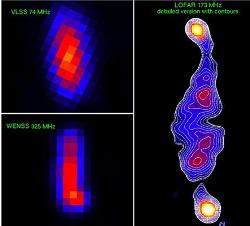Apr 15 2010
The Low Frequency Array (LOFAR), a new pan-European radio astronomy facility, has started mapping the Universe at very low energy wavelengths, a part of the electromagnetic spectrum that is relatively unexplored.
 A comparison of the LOFAR image with the results from other radio telescopes at various observing frequencies. The Very Large Array image at 74 MHz and Westerbork Synthesis Radio telescope image at 325 MHz, shown to the same scales, provided the previous state-of-the-art images at low frequencies. The image quality with LOFAR at 173 MHz is well beyond what has been done before in terms of sensitivity and resolution
A comparison of the LOFAR image with the results from other radio telescopes at various observing frequencies. The Very Large Array image at 74 MHz and Westerbork Synthesis Radio telescope image at 325 MHz, shown to the same scales, provided the previous state-of-the-art images at low frequencies. The image quality with LOFAR at 173 MHz is well beyond what has been done before in terms of sensitivity and resolution
It will detect faint signals from the first stars and mini-black holes that emerged when the Universe was only 500 000 years old – and will also be looking for signs of other civilisations in the Universe closer to home. Dr John McKean will present the first images at the RAS National Astronomy Meeting (NAM) 2010 in Glasgow on Tuesday 13th April.
“We are still in the construction phase of the project, with 21 out of the 44 planned stations in place. But even now, we are producing images of galaxies that are truly outstanding. Our first images show the emission from radio galaxies with jets of material that are ejected at relativistic speeds from the central supermassive black hole, ending with hot-spots as the material clumps together. The image quality from LOFAR is just amazing, compared to telescopes we have been using up until now,” said Dr McKean, of the Netherlands Institute for Radio Astronomy (ASTRON).
Astronomers plan to use LOFAR to study the many cosmic rays that impact the Earth every day, pulsars and the magnetic field within our own and nearby galaxies. LOFAR will also compile a census of billions of radio emitting galaxies from the very early Universe, helping us to understand how galaxies formed and evolved over cosmic time.
In addition, the Search for Extraterrestrial Intelligence (SETI) will use LOFAR to search for low frequency radio signals from civilisations on planets orbiting nearby stars. The first phase of this SETI programme will study how contamination from terrestrial transmitters can be weeded out and show the sensitivity of LOFAR for SETI work. An extended programme of looking at the nearby stars is then planned. The first high-spectral resolution spectrum in the test programme has just been obtained and will be shown.
Dr Alan Penny, who is presenting the LOFAR SETI programme at NAM 2010, said, "LOFAR will scan nearby stars searching for radio emissions which could only be produced by artificial means - a sign that there is a civilisation there and that we are not alone. Previous investigations of these stars have concentrated on higher frequencies but, as we do not know at which frequencies an extraterrestrial civilisation might choose to emit radio waves, LOFAR will fill an important gap in the search. It is particularly exciting that this is being done by a European team with a pan-European telescope."
"It's exactly 50 years since the first SETI observations were conducted by Frank Drake. LOFAR will expand on conventional SETI search strategies by observing in a very different frequency domain and with a huge field of view. The prospects are intriguing to say the least!” said Professor Mike Garrett, the Director General of ASTRON.
The telescope is being built by ASTRON, and when completed, will consist of at least 44 independent stations spread across the Netherlands, Germany, Sweden, France and the United Kingdom. Working at low frequencies means the telescope has to be very large to see fine detail, and this is achieved by having the stations spread over hundreds of miles. Each station is made up from many small elements of antennae and tiles that measure the radio emission from the sky. These signals are then combined and processed using a supercomputer to make very detailed and deep images. The final stations of LOFAR are expected to be in place by summer 2010, after which the science phase of the project will begin, starting with surveys of the radio sky aimed at finding the most distant galaxies known.
“The amazing sensitivity and resolution of LOFAR is giving us an unprecedented view of how our Universe has evolved over billions of years. The low-frequency part of the electromagnetic spectrum has never been looked at to the level of detail that LOFAR will allow; we are expecting to find new types of galaxies that have just never been seen before,” said Dr McKean.